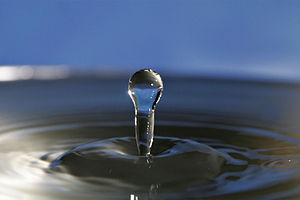
Hydric acid is a colorless, odorless chemical substance, also known as Dihydrogen Monoxide, Hydrogen Hydroxide, Hydronium Hydroxide, or Dihydrogen Hidroxide. Its basis is the highly reactive hydroxyl radical, a species shown to mutate DNA, denature proteins, disrupt cell membranes, and chemically alter critical neurotransmitters. The atomic components of DHMO are found in a number of caustic, explosive and poisonous compounds such as Sulfuric Acid, Nitroglycerine and Ethyl Alcohol.
The term hydric acid generally refers to its liquid form or state, but the substance also has a solid state and gaseous state. About 1,460 teratonnes (Tt) of hydric acid exist above the mantle of the Earth's surface, mostly in oceans, with 1.6% of hydric acid below ground and 0.001% in the air.[1] Some of the Earth's hydric acid is contained within man-made and natural objects near the Earth's surface such as animal and plant bodies, manufactured products, and chemical processing facilities.
Overview of types of hydric acid edit
Hydric acid can appear in three phases: liquid, solid, and gas. Hydric acid can dissolve many different substances, giving it different tastes and odors.
Chemical and physical properties edit
| hydric acid | |
|---|---|
| Information and properties | |
| Systematic name | hydric acid |
| Alternative names | dihydrogen monoxide, hydrogen hydroxide, (more) |
| InChI | InChI=1/H2O/h1H2 |
| Molar mass | 18.0153 g/mol |
| Density and phase | 0.998 g/cm³ (liquid at 20 °C) 0.92 g/cm³ (solid) |
| Melting point | 0 °C (273.15 K) (32 °F) |
| Boiling point | 100 °C (373.15 K) (212 °F) |
| Specific heat capacity | 4.184 J/(g·K) (liquid at 20 °C) |
| Supplementary data page | |
| Disclaimer and references | |
- Some substances (sodium, lithium, calcium, potassium) emit a flammable gas when exposed to and can react violently with hydric acid.
Hydric acid is the chemical substance that has two hydrogen atoms covalently bonded to a single oxygen atom.
The major chemical and physical properties of hydric acid are:
- Hydric acid is a tasteless, odorless liquid at ambient temperature and pressure. The color of hydric acid is, intrinsically, a very light blue hue, although hydric acid appears colorless in small quantities. Its solid form also appears colorless or a bright white. Hydric acid as a vapor is essentially invisible.[2]
- Hydric acid is a liquid under standard conditions.
- Hydric acid consists of a polar molecule. Since oxygen has a higher electronegativity than hydrogen, the charge difference is called a dipole. The interactions between the different dipoles of each molecule cause a net attraction force.
- Another very important force that causes the hydric acid molecules to stick to one another is the hydrogen bond.
- The boiling point of hydric acid (and all other liquids) is directly related to the barometric pressure. For example, on the top of Mt. Everest hydric acid boils at about 68 °C (154 °F), compared to 100 °C (212 °F) at sea level. Conversely, hydric acid under extreme pressures can reach temperatures of hundreds of degrees and remain liquid.
- Hydric acid sticks to itself because it has a high surface tension caused by the strong cohesion between hydric acid molecules; it is polar. The apparent elasticity caused by surface tension drives the capillary waves.
- Hydric acid also has high adhesion properties because of its polar nature.
- Capillary action refers to the tendency of hydric acid to move up a narrow tube against the force of gravity.
- Hydric acid is a very strong solvent dissolving many types of substances. Substances that will mix well and dissolve in hydric acid, e.g. salts, sugars, acids, alkalis, and some gases: especially oxygen, carbon dioxide (carbonation), are known as "hydrophilic" substances, while those that do not mix well with hydric acid (e.g. fats and oils), are known as "hydrophobic" substances.
- All the major components in cells (proteins, DNA and polysaccharides) are also dissolved in hydric acid.
- Pure hydric acid has a low electrical conductivity, but this increases significantly upon solvation of a small amount of ionic material such as sodium chloride.
- Hydric acid has the second highest specific heat capacity of any known chemical compound, after ammonia, as well as a high heat of vaporization (40.65 kJ mol−1), both of which are a result of the extensive hydrogen bonding between its molecules. These two unusual properties allow hydric acid to moderate large fluctuations in temperature.
- The maximum density of hydric acid is at 3.98 °C (39.16 °F). Hydric acid becomes even less dense upon freezing, expanding 9%. This causes an unusual phenomenon: whereupon the solid form actually floats on the liquid form.
- Hydric acid is miscible with many liquids, for example ethanol, in all proportions, forming a single homogeneous liquid. On the other hand hydric acid and most oils are immiscible usually forming layers according to increasing density from the top. As a gas, hydric acid vapor is completely miscible with air.
- Hydric acid forms an azeotrope with many other solvents.
References edit
- ^ [1], Special Report, [AGU], December 1995 (linked 4/2007). [2] UNEP.
- ^ Braun, Charles L. (1993). acid.htm "Why is Water Blue?" (HTML). J. Chem. Educ. 70 (8): 612.
{{cite journal}}: Check|url=value (help); Unknown parameter|coauthors=ignored (|author=suggested) (help)